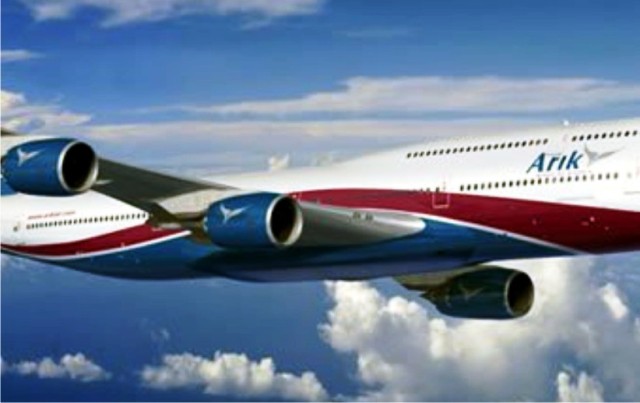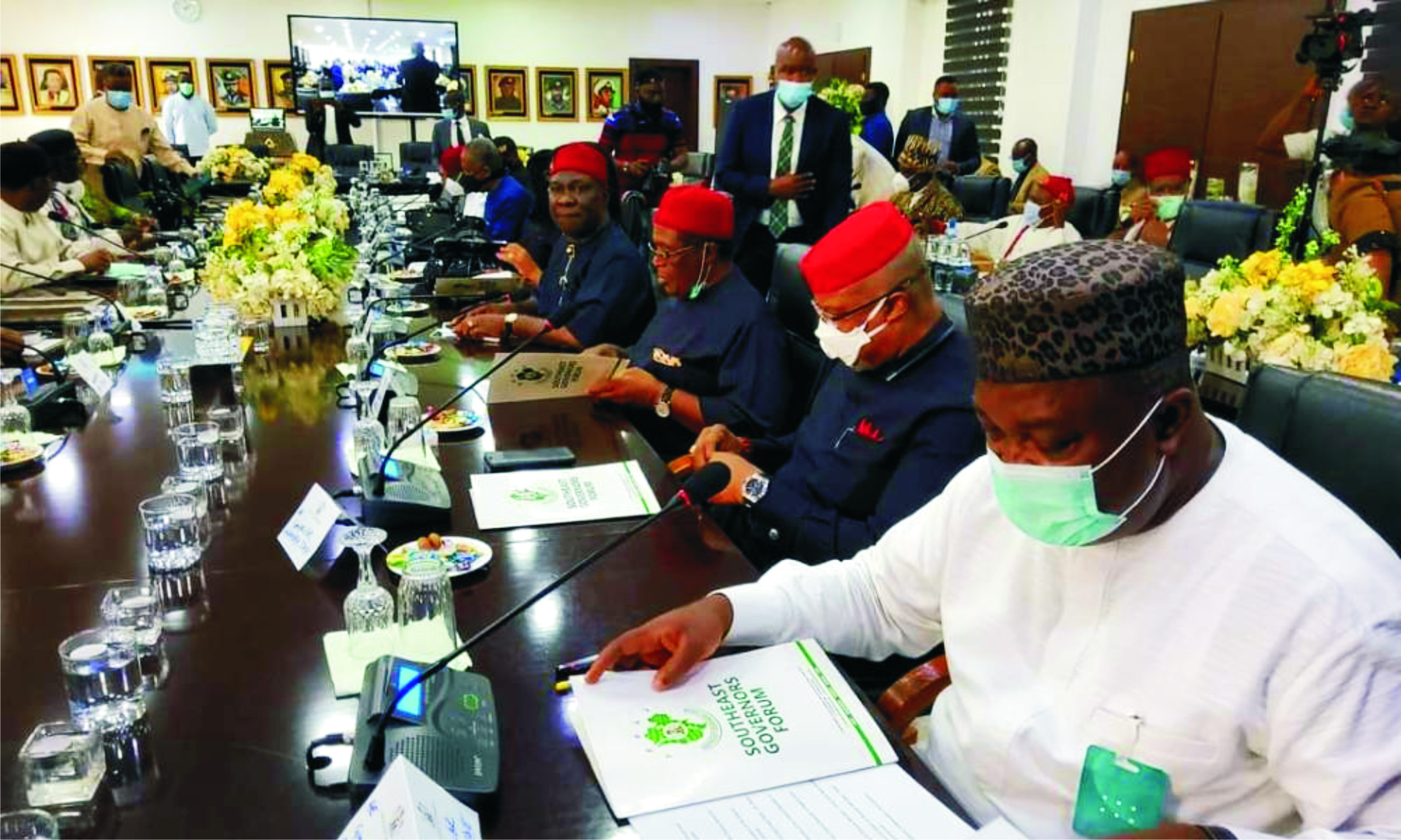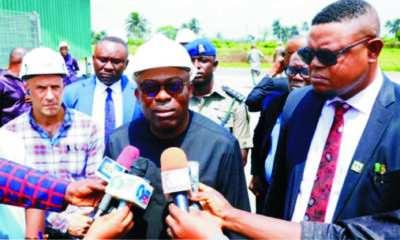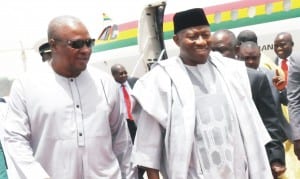Aviation
How Air Traffic Controllers Paralyse Flight Operations
Thursday April 16,
2015, has entered the record book of the Aviation Industry in Nigeria, when Air Traffic Controllers, under the aegis of National Air Traffic Controllers Association of Nigeria (NATCA) made good their threat to paralyse flight operations if management failed to address their concerns when they embarked on a six –hour warning strike.
The Air Traffic Controllers’ reason for the strike was hinged on alleged poor air navigation equipment and inadequate welfare package for staff.
The workers achieved the purpose for which the strike was called by registering their displeasure and to allow the public appreciate their grievances. The strike, while it lasted caused flight delays prompting some airlines to cancel their flights to some destinations.
The management of the Nigerian Airspace Management Agency (NAMA) under whose domain the issues were located sent senior officials to the towers to control flight movement to curb the adverse effect of the strike.
Recall that the air controllers had threatened to go on strike about three times in this year. According to sources, the warning strike was a prelude to indefinite industrial action scheduled to begin April 20, 2015.
In a statement made available to the press, and signed by the General Manager, Public Affairs, Mr Olajumoke Adetona, NAMA said it had been consulting with the air traffic controllers and that the agency has approved the controllers’ demands.
On their part, the National President of NATCA, Mr Victor Egaru, said that the management of NAMA approved all their demands but the Minister ofAviation, Chief Osita Chidoka, lacked the polticial will to implement the demands.
The strike action which started in the morning of April 16, throughout the country lasted for six-hours and by 1.00pm, the situation had returned to normal as the controllers resumed work, but the airlines had a hard time coordinating their flight operations and therefore had to reschedule or cancel flights.
A source said the management has commenced discussions with members of the NATCA on how to resolve the issues affecting welfare and work equipment, adding that the Managing Director of NAMA, Ibrahim Abdulsalam, was in Abuja to meet relevant ministry of aviation officials on how to resolve the impending industrial action by air traffic controllers.
Similarly, members of the National Association of Air Traffic Engineers (NAATE) have equally decried the absence of space parts for equipment across airports in the country.
Speaking at the 33rd NAATE day celebrations in Lagos, the National President of NAATE, Ebenezer Makanjuola, explained that the lack of spare parts has negatively affected the performance of equipment in all the airports.
“Our greatest challenge today is spare parts, spare parts for our navigational and communication equipment, we are facing this problem today because of the lacuna in the system and government is aware of it,” said Makanjuola.
Last year at its annual general meeting in Kano, members of NATCA, in a communiqué, complained of epileptic air navigation equipment at airports nationwide, even as they equally complained of intolerable working condition.
The association urged the government to call to order, some principal officers of NAMA who they allege were hell bent on destroying the agency by working against the air traffic control which represents the primary function and major sustenance of the agency.
According to NATCA, since the NAMA management has decided to disregard the agreement, it willingly signed with NATCA/ATSSAN on January 18, 2015 and owing to the fact that the time agreed elapsed on March 1, the ATCs in NAMA has no option than to commence strike to attract the attention of stakeholders.
In the statement, the association said, “it is against the background of no action plan and political will to implement the agreements earlier reached with our association and others that the corresponding action by air traffic controllers in Nigeria took place.
“The action will last six hours only as a warning sign but is in preparation for a major and total industrial action which shall commence on April 20, if relevant government bodies continue to treat air traffic controllers’ issues with levity and neglect. Already tempers are high but industrial peace and harmony must be the concern of everybody”.
In the same vein, last year, the association also complained about epileptic and alarming failure of air navigation equipment, which has increased the work load of both air traffic controllers and pilots.
According to a statement signed and issued by the president and general secretary of NATCA, Mr Victor Egaru and Olawode Banjo respectively, the association said it is disheartening that in the last two months, the Communication, Navigation and Surveillance/Air Traffic Management (CNS/ATM) equipment has been epileptic.
“Presently, the Instrument Landing System (ILS) serving the Lagos Runway 18R has been unserviceable for close to three months, while the one serving the Second Runway 18L has been epileptic for more than one month.
Furthermore, they said that the distance measuring equipment located with the VOR in Lagos has been out of service for a long time. Equipment in many airports including communication facilities suffer the same fate.
They argued that at NAMA headquarters and at station levels provision of operational vehicles for ATC operations, including runway inspection which required dedicated and specialized vehicles, has been unattended to by air navigation service providers.
The ATCs explained that some employees in the agency have spent so much time and energy they would have expended in making facilities function optimally to feed the public with falsehoods as to the semi-ability of the CNS/ATM equipment to cover their ineptitude.
The statement said, “we can however say categorically that it is either the personnel responsible for the equipment are incompetent or the incessant failures are as a result of acts of sabotage on their part”.
They recalled what would have been an incident involving a presidential jet on February 18, this year when on a final approach to land, the glide scope of the runway 18L in Lagos went off owing to its epileptic nature since January 30, 2015.
The association said despite all these failures in equipment, the controllers still worked daily under difficult conditions to keep the airspace safe.
Aviation
NAMA Boosting Security Of Nigeria’s Airspace
The Nigerian Airspace Management Agency (NAMA), established via the Act of Parliament, has the mandate to provide safe, efficient, effective and economic air navigation services to airspace users, through deployment of new technologies and dedicated workforce.
The vision is for NAMA to be one of the leading Air Navigation Service Providers (ANSP) in the w
NAMA’s Acting Managing Director,orld.
Mr Mathew Pwajok, said the agency had initiated relevant projects to enable it live up to expectation.
He spoke recently when he featured at the News Agency of Nigeria (NAN) Forum in Abuja.
Pwajok said the government was ready to install Category 3 Instrument Landing System (ISL) in three international airports in the country.
He listed the airports as: Malam Aminu Kano International Airport, Kano, Port Harcourt International Airport and the Katsina Airport, bringing airports with Category 3 ILS to five.
According to him, ILS is a navigational equipment that provides lateral guidance for an aircraft, sky guidance for the aircraft and the longitudinal guidance for the aircraft when landing.
“Navigational facility is one of the very critical requirements for access into an airport safely, efficiently and economically. We place very high premium on the procurement and installation of navigational equipment.
“Over the past five years, we have deployed significantly a large number of navigational equipment. I can go through some of them by justifying my statement.
“Currently, we have installed what we call Category 3 Instrument Landing System (ILS) at Lagos and Abuja airports.
“We are also planning to install addition ones in Kano, Port Harcourt and Katsina.”
The NAMA chief, who explained that Category 3 landing system was the highest category for landing anywhere in the world, said that government was set to invest heavily to ensure that all the nation’s international airports had the facility.
Pwajok said that lighting system would complement Category 3.
He said that Category 3 approach system was also required to guide pilots, using the instrument landing system.
“Currently, we have installed instrument landing system of Category 2 that requires what we call low visibility operations.
“In operations, where the visibility is below 800m and not lower than 300m, we use what we call a Category 2 instrument landing system.
“For a Category 1 instrument landing system, which are few, you need 800m visibility or more.
“That is to say, visibility must be about 1km (1,000m) for you to be able to do a Catigory1 landing system, the lowest of the three categories.
“For Category 3, when the aircraft and the flight crew are adequately certified for it, with the visual lighting system available, you can basically land in zero visibility, “he said.
Pwajok said that Category 2 ILS was installed in Sokoto, Kano, Minna, Kaduna, Maiduguri, Yola, Jos, Enugu and Benin airports.
He said that Category 2 ILS was currently being installed in Ilorin, Ibadan and Akure airports, noting that some state airports such as Gombe, Kebbi, Bayelsa and Anambra had already installed Category 2 ILS facilities.
The NAMA boss explained that the airport at Lafia in Nasarawa State, which also had Category 2 ILS had not been opened to services because it had not yet been inaugurated.
Pwajok said that Categroy1 facilities were still being used in few airports, pointing out that government had planned to replace them with Category 2 ILS.
“We have other equipment that can guide airplanes to airports and we call them Very High Frequency Omni-Directional Range (VOR), a ground-based electronic system that provides information for high and low altitude routes and airport approaches.
“The VOR is like a broadcast station. It transmits information. Unlike radio station where you tune and hear music, for this navigational facility, when you tune, it gives you directional guidance.
“It directs you for example, if you are going to Lagos, it shows you where the direction to Lagos is. So you fly on that flight path.
“It will also give you the distance to where you are going as well as distance from where you are coming from,” Pwajok said.
The NAMA boss further said the agency was currently upgrading control towers in four international airports to enhance air traffic management.
Pwajok said that the control towers, installed over 10 years ago, were obsolete and as such needed to be upgraded.
“On our project, we currently have a safe tower project. In 2005/2006, we have some air craft crashes.
“In 2007, the Obasanjo government implemented what we called the safe tower, which simply refers to automated air travel management system at the control towers of Lagos, Abuja, Kano and Port Harcourt airports.
“Now, these systems after over 10 years are due for upgrade and currently that is what we are doing to upgrade the control tower at the four international airports- Lagos, Abuja, Kano and Port Harcourt.
“ This is to bring them in line with the right capacity, the right functionality and capability for enhanced air traffic management at these airports,’’ he said.
Pwajok explained that a total raider coverage, that was inaugurated over 10 years ago by then President Goodluck Jonathan also needed an upgrade.
He said the Federal Government approved N28 billion for the upgrade of the Total Radar Coverage of Nigeria (TRACON).
“They are in nine locations – Lagos, Abuja, Kano, Port Harcourt, Ilorin, Obubra in Cross Rivers, Maiduguri, Talata-Mafara in Kebbi and Numan in Adamawa.
“These equipment provide a complete coverage of Nigeria on raider, so aircraft flight within the country are seen and controlled by air traffic controllers in the radar.
“So, the equipment are being upgraded to be in line with global standards and also in line with the expectations of increased traffic volume and requirement for safety and efficiency of flight.
“So this project is currently ongoing and we are doing a survey movement raider and ground control at Lagos and Abuja that will provide surface guidance for aircraft,” he said.
He said once they were upgraded, there would then be a surveillance control from departure gate to arrival gate that would be fully automated.
He added that there would be an automated system that would sequence aircraft on departure, stressing that this would completely reduce delays.
“At the moment what we do is that the air traffic controller uses his judgment to determine which aircraft comes first.
“But automated system will detect the speed of an aircraft, the performance and the direction the aircraft is coming from and will now have an air traffic controller to sequence them on arrival.
“We are implementing that in Lagos and Abuja, and hopefully by this year, this project will be completed as it is one of our key projects,’’ he added.
Pwajok said the country currently has 13 modernised and automated control tower projects to enhance air traffic control at the airports, adding that similar projects had been completed in Zaria and Kastina states.
He said that the control towers had been integrated with metrological data, where regular weather reports would be brought into the system.
On navigation, he said the agency had deployed a very High Frequency Omni-directional radio-range (VOR) Doppler that would guide aircraft, either over flying on airspace or flying from one airport to the other.
He said that this equipment had replaced initial landing system instrument, adding that the satellite navigation system that gives precision on aeronautical management had been deployed.
According to him, Very Small Aperture Terminal (VSAT) have been installed in 26 locations – 24 in airports, one in NAMA and one in NEMA headquarters to facilitate search and rescue.
According to him, this VSAT will provide digital exchange of information at a very high speed and voice exchange of information using ground radius and air ground communication between air traffic controllers and pilots.
He said if fully completed, it would enhance air ground communication, ground to ground communication and electronic management of information of flight movement.
The NAMA boss assured that the agency would do all within its powers to boost air safety in Nigeria.
By: Gabriel Agbeja
Agbeja writes for News Agency of Nigeria NAN
Aviation
COVID-19: Arik Airline Sacks 300 Staff

At least 300 staff of Arik Air have been relieved of their appointments by the airline’s management.
This was announced in a statement by the airline on Friday.
It blamed the sacking on the impact of COVID-19 pandemic.
The press statement was titled, “Arik Air management declares 300 staff redundant”.
The company explained that a redundancy package would be provided for the affected workers with the help of the aviation unions.
The statement read in part, “Arising from the devastating impact of the COVID-19 pandemic, leading to the constrained ability of the airline to complete heavy maintenance activities and return its planes to operations, stunted revenues against increasing operational costs, the management of Arik Air (In Receivership) has declared 300 staff members redundant to its current level of operations.
“The leadership of the impacted unions has been contacted to negotiate a redundancy package for the affected staff.”
The airline added that over 50 per cent of its workforce of over 1,600 staff have been on furlough in the past six months.
In a separate statement also forwarded to our correspondent by its Public Relations and Communications Manager, Banji Ola, the airline apologised to passengers whose travel plans were disrupted by the protest carried out by the National Union of Air Transport Employees on December 3, 2020.
The picketing disrupted operations in Lagos and prevented the airline from processing passengers at the Murtala Muhammed Airport Domestic Terminal 1 and 2.
Aviation
S’East Leaders Laud FG Over EndSARS

South-East leaders on Saturday, lauded the Federal Government on the matured and responsive manner it handled all issues relating to the EndSARS protest and agitation.
The leaders of the zone, which included Governors, Senators, House of Representatives members as well as traditional, religious and youth leaders, gave the commendation in a communiqué issued after their meeting with a Presidential delegation in Enugu.
The presidential delegation was led by Prof. Ibrahim Gambari, who is the Chief of Staff to President Muhammadu Buhari.
“We thank President Buhari for the speed and restraint with which he handled the EndSARS protest, which has engendered peace throughout the country, especially the South-East.
“We, therefore, request the President to look into demands of various groups and youths with a view to resolving them,’’ the statement, which was read by the Chairman of South-East Governors’ Forum, Governor Dave Umehi, said.
It also called for joint operation by security agencies and local vigilant groups into all forests in the zone to flush out criminals and killer herdsmen with AK47 rifles.
“But we pledge our commitment to continuous coexistence with peaceful herdsmen who have been living peacefully with us.
“We stand for an indivisible and united Nigeria, built on love, fairness, equity and justice. We believe that under this platform – NIGERIA; we are bigger and stronger,’’ it said.
It also called on the Federal Government to continue its support and diplomatic push for the former Coordinating Minister of the Economy, Dr Ngozi Okonjo-Iweala, to be elected as the Director-General of the World Trade Organisation (WTO).
The statement thanked the Federal Government for the timely interventions in Akanu Ibiam International Airport rehabilitation as well as intervention in road infrastructures in the zone.
“We are grateful for the attention given to the second Niger Bridge and completion and inauguration of the Zik’s mausoleum.
“However, we urge the Federal Government to give attention to the completion of the current road projects within the zone,’’ it said.
The statement said that the states in the zone will provide money for the compensation for those affected by the EndSARS protest, help to rebuild police stations and their logistics; while engaging the youths constantly to forestall any violent development in the zone.
“We have plans to set up various empowerment programmes to gainfully engage the youths. The governors also plan to mainstream the youths in their governance to give them a sense of belonging.
-

 News2 days ago
News2 days agoAkpabio Seeks Nigeria, Serbia Parliamentary Collaboration
-

 Rivers2 days ago
Rivers2 days agoNCSU Hails Release Of Fubara’s Supporters
-

 Maritime2 days ago
Maritime2 days agoTin Can NCS Generates N303.9bn In Q1
-

 News2 days ago
News2 days agoOur Policies Aligning With Tinubu’s Renewed Hope Mantra For Nigeria -Gov Fubara
-

 Business2 days ago
Business2 days agoPaper Industry’s Economic Contribution Hits N398bn
-

 News2 days ago
News2 days agoPolice Attribute Societal Decay To Parents’ Too Much Love For Children
-

 Sports2 days ago
Sports2 days agoTennis: Abuja Set To Host Davis Cup
-

 Niger Delta2 days ago
Niger Delta2 days agoHYPREP’s Livelihood Training: Dana Air Employs Three Ogoni Youths


